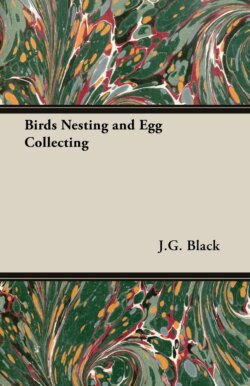Читать книгу Birds Nesting and Egg Collecting - J. G. Black - Страница 12
На сайте Литреса книга снята с продажи.
$ 2. WHERE TO LOOK.
ОглавлениеRoads.—Roadsides are not such good hunting grounds as they used to be, owing to the amount of dust that motor cars raise; but the lanes and by-roads are still fairly free from this nuisance, and wherever you are going to a good part of your walk is likely to be on the hard road. Your long stick is very useful for beating hedges and banks and the near sides of ditches, and you save a lot of time by its use, as without it you would be looking into all sorts of holes, most of which would turn out to be false alarms. If there are four of you going along a road, it is best for two to take the sides of the road, and the other two the further sides of the hedges, so as to miss nothing. If you are alone it will generally be better to hunt the sunny side, unless the other has very much better cover.
Any kind of hedge is worth looking at, but especially the small, well-clipped sort, and the very tall. Steep banks, old walls with crevices in them, beds of nettles, and bramble-bushes are all useful places along a roadside; and ivy-covered walls nearly always produce something, though ivy on trees is not quite so good. The only way to hunt a dry ditch is to walk right along it. You not only see both sides of the ditch, but get nearer to the hedge beyond.
Woods.—Big woods look tempting, but small ones are generally better for nesting. If you see Jays or Magpies about a small wood you can find their nests quickly enough, but you may spend a long day in a big wood and have very little to show for it. Then the smaller birds are hardly to be found except round the edges of the big wood, while a small one with undergrowth may have nests in any part and at any level. A good plan with a small wood is to go up to every nest early in the season and throw down all old Woodpigeons’ and Squirrels’ nests, leaving the Magpies’ and Carrion Crows’ and Sparrow-hawks’ on the chance of a Kestrel or an Owl taking them on (unless they are very ancient, or the trees very hard to climb).
Perhaps the best wood of all is a long strip with a burn running through or beside it. As to trees, fir woods give better results up aloft as a rule, while oak, beech, etc., show a greater number of small birds on the ground floor. So if your strip has some of each, you’ve got the ideal wood for birds nesting.
Water.—Ponds are always worth visiting, and marshes likewise; there may not be a great variety of birds, but there may be some rare ones. And you can get as wet as you like, perhaps wetter.
Running water seems to attract any number of birds, and there is no better plan for a birdnesting ramble, long or short, than to follow the course of a stream. It seems to lead straight from one good place to another, and such a walk will introduce you to more different birds in the time than any other I know of.
Open Country.—In going across country, besides ponds, marshes, small woods, good hedges and thickets, which I have mentioned already, the things best worth turning aside for are quarries, especially disused, old limekilns, ruins, outlying cow-byres, rough corners of fields, and single bushes. Of course any stretch of heather or bent grass has its own particular set of birds, and a bracken-covert may hold a Woodcock early in the season, a Greyhen in the middle, or a Nightjar at the end. Whins, too, are very favourite nesting places, and you can tackle them better when they lie in scattered clumps than when they are all in a thick solid mass. If you come across a young fir plantation, with the trees about shoulder-high, and plenty of rough grass below, you are sure to find something in it, especially round the edges.
Dwelling-Houses.—Finally, although some birds have to be sought right out in the wilds, it is always worth while to make a careful search, if possible, in gardens, farm-buildings, etc., as this list of birds that have been found nesting in the grounds of Corchester will show. And there are few places where they have to put up with so much noise and disturbance:—
Thrush.
Missel Thrush.
Hedge Sparrow.
Greenfinch.
Redpoll.
Whitethroat.
Willow Wren.
Wren.
House Martin.
Blue-tit.
Coal-tit.
Pied Wagtail.
Pheasant.
Goldcrest.
Blackbird.
Robin.
Chaffinch.
House Sparrow.
Yellowhammer.
Garden Warbler.
Starling.
Swallow.
Skylark.
Great-tit.
Spotted Flycatcher.
Wheatear.
Partridge.
Lesser Whitethroat.
Woodpigeon.
